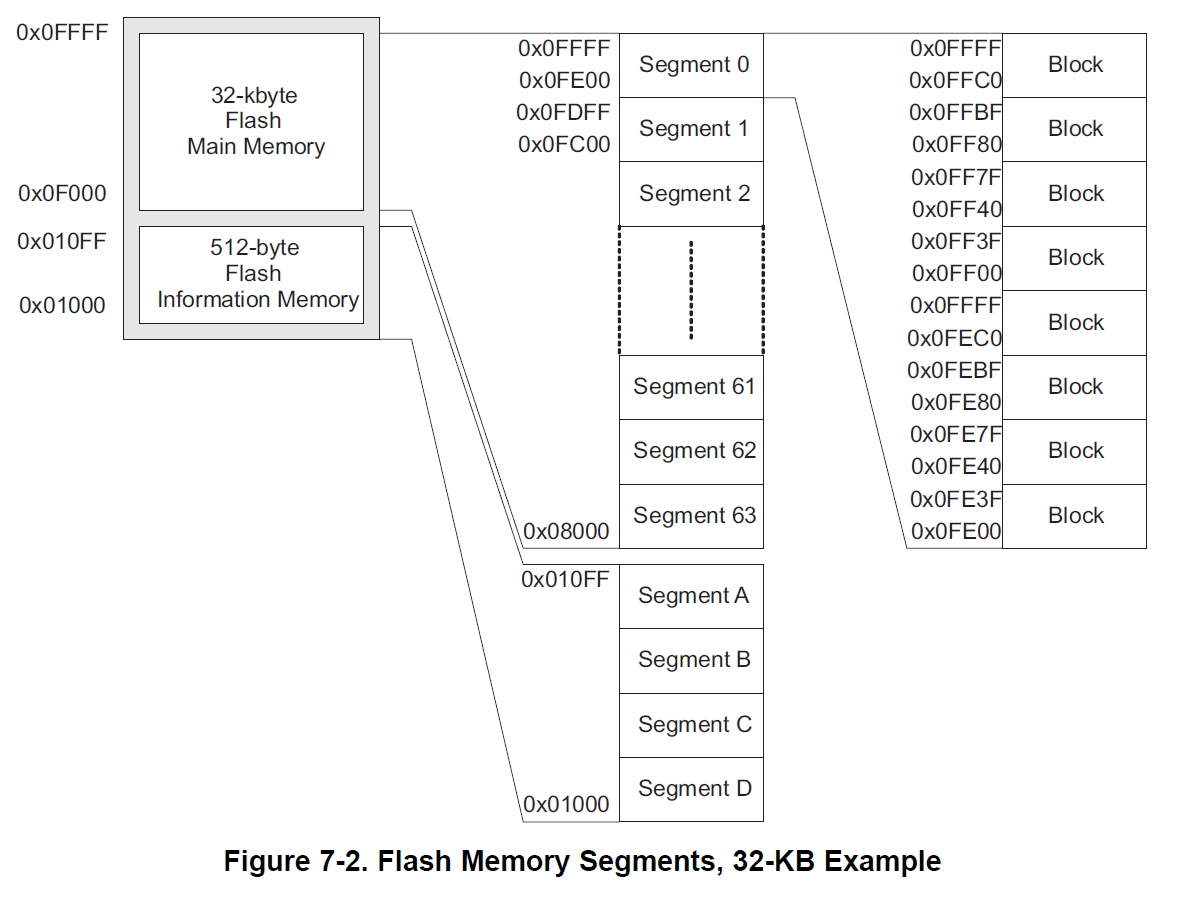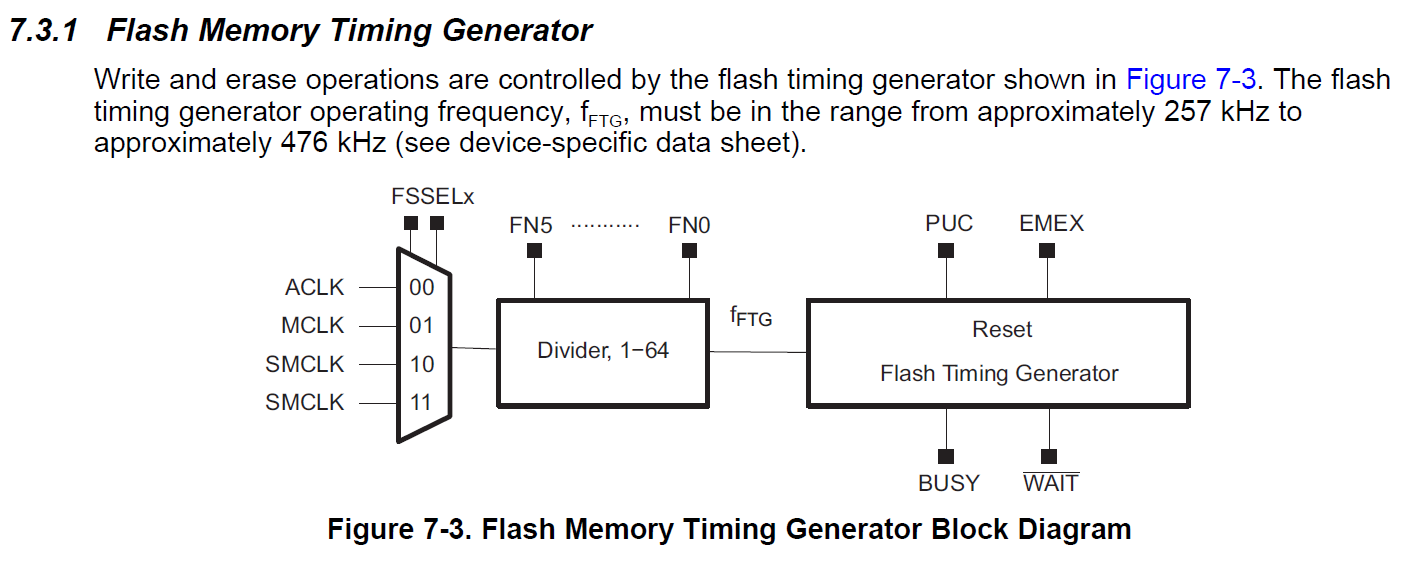MSP430 - Flash-Speicher
Funktionsweise
- Vorbild: EEPROM (electrically erasable programmable read-only memory)
- Flash-Speicher besitzt 3 Zugriffoperationen:
- READ: Daten können jeder Zeit und schnell vom Flash-Speicher gelesen werden
- ERASE: Bits des Flash-Speichers können in ihren Ausgangszustand nur in großen Blöcken auf einmal zurückgesetzt werden
- WRITE: Bits können sehr schnell geschrieben werden und aus ihren Ausgangszustand ausgelenkt werden, jedoch ein Zurücksetzen in den Ausgangszustand ist nur durch ein ERASE möglich!
Schreiben und Lesen von Daten des Flash-Speichers des MSP430
Adressierung des Flash-Speichers

- Unterteilung des MSP430-Flash in verschiedene Segmente
- Eine ERASE-Operation löscht ein Segment vollständig. D. h. alle Speicherzellen werden auf den Wert
0xffgesetzt. - Segment A-D: jeweils 64 Bytes groß
- Segment A enthält Kalibrierungsdaten und sollte nicht gelöscht werden:
- Zusätzliches LOCKA-Bit zum Entsperren des Segmentes A
- Kalibrierungsdaten:
CALBC1_1MHZ,CALDCO_1MHZfür die Kalibrierung des Basic Clock Module für 1, 8, 12 oder 16 MHz- Kalibrierung des ADC (Offset, Gain)
- Kalibrierung des Temperaturssensors
- Kalibrierung des Referenzspannungsquellen des ADC
- Segmente B-D stehen zur freien Verfügung
- Segmente 0 - 63 enthalten jeweils 512 Bytes (64 · 512 = 32 KB)
- C-Compiler speichert das Programm ab
0x8000
Speicherauflistung des Projektes siehe Projektpfad/Debug/ProjectName.map
SECTION ALLOCATION MAP
output attributes/
section page origin length input sections
-------- ---- ---------- ---------- ----------------
.stack 0 000005b0 00000050 UNINITIALIZED
000005b0 00000002 rts430_eabi.lib : boot.c.obj (.stack)
000005b2 0000004e --HOLE--
.text 0 00008000 000000be
00008000 00000046 main.obj (.text:main)
00008046 00000022 main.obj (.text:flash_write)
00008068 0000001e main.obj (.text:flash_erase)
00008086 00000014 rts430_eabi.lib : boot.c.obj (.text:_c_int00_noinit_noargs)
0000809a 00000012 main.obj (.text:PORT2_ISR)
000080ac 00000008 rts430_eabi.lib : isr_trap.asm.obj (.text:_isr:__TI_ISR_TRAP)
000080b4 00000006 : exit.c.obj (.text:abort)
000080ba 00000004 : pre_init.c.obj (.text:_system_pre_init)
- Segment 0 enthält den Interrupt-Vector und darf auf keinen Fall überschrieben werden
Programmierung
- Zugriff auf eine Speicherzelle in C mit Hilfe von Zeigern:


Einstellen des Taktgebers für den FMC (8_2a_flash)
ERASE-Operation (8_2a_flash)
void flash_erase(uint8_t *address) {
FCTL3 = FWKEY; // Clear Lock bit
FCTL1 = FWKEY + ERASE; // Set Erase bit
*address = 0; // Dummy write
FCTL1 = FWKEY; // Clear Erase bit
FCTL3 = FWKEY + LOCK; // Set LOCK bit
}
→ Das gesamte Segment, in dem sich
address befindet, wird gelöscht
WRITE-OPERATION (8_2a_flash)
void flash_write(uint8_t *address, uint8_t value) {
FCTL3 = FWKEY; // Clear Lock bit
FCTL1 = FWKEY + WRT; // Set WRT bit for write operation
*address = value; // Write
FCTL1 = FWKEY; // Clear WRT bit
FCTL3 = FWKEY + LOCK; // Set LOCK bit
}
Hochzählen des Wertes im Flash-Speicher (8_2a_flash)
uint8_t new_value = *data_pointer + 1;
flash_erase(data_pointer);
flash_write(data_pointer, new_value);
!!! ACHTUNG: Andere Werte in Segment D gehen verloren!
Gesamtes Programm
#include <msp430.h>
#include <stdint.h>
void update_led();
void flash_init();
void flash_erase(uint8_t *address);
void flash_write(uint8_t *address, uint8_t value);
static uint8_t *data_pointer = (uint8_t *) 0x1000;
int main(void) {
WDTCTL = WDTPW | WDTHOLD; // stop watchdog timer
BCSCTL1 = CALBC1_1MHZ;
DCOCTL = CALDCO_1MHZ;
// RGB LED
P2OUT &= ~(BIT1 + BIT3 + BIT5);
P2DIR |= BIT1 + BIT3 + BIT5;
update_led();
// Button
P1DIR &= ~BIT3;
P1OUT |= BIT3;
P1REN |= BIT3;
P1IES |= BIT3;
P1IFG &= ~BIT3;
P1IE |= BIT3;
flash_init();
__enable_interrupt();
while (1) {
__low_power_mode_3();
uint8_t new_value = *data_pointer + 1;
if (new_value >= 6) {
new_value = 0;
}
flash_erase(data_pointer);
flash_write(data_pointer, new_value);
update_led();
}
}
void update_led() {
switch (*data_pointer) {
case 0:
P2OUT |= BIT1;
P2OUT &= ~(BIT3 + BIT5);
break;
case 1:
P2OUT |= BIT1 + BIT3;
P2OUT &= ~ BIT5;
break;
case 2:
P2OUT |= BIT3;
P2OUT &= ~(BIT1 + BIT5);
break;
case 3:
P2OUT |= BIT3 + BIT5;
P2OUT &= ~BIT1;
break;
case 4:
P2OUT |= BIT5;
P2OUT &= ~(BIT1 + BIT3);
case 5:
P2OUT |= BIT1 + BIT5;
P2OUT &= ~BIT3;
break;
}
}
void flash_init() {
FCTL2 = FWKEY + FSSEL_1 + FN1; // SMCLK / 3 -> 333 kHz
}
void flash_erase(uint8_t *address) {
FCTL3 = FWKEY; // Clear Lock bit
FCTL1 = FWKEY + ERASE; // Set Erase bit
*address = 0; // Dummy write
FCTL1 = FWKEY; // Clear Erase bit
FCTL3 = FWKEY + LOCK; // Set LOCK bit
}
void flash_write(uint8_t *address, uint8_t value) {
FCTL3 = FWKEY; // Clear Lock bit
FCTL1 = FWKEY + WRT; // Set WRT bit for write operation
*address = value; // Write
FCTL1 = FWKEY; // Clear WRT bit
FCTL3 = FWKEY + LOCK; // Set LOCK bit
}
#pragma vector=PORT1_VECTOR
__interrupt void PORT1_ISR() {
if (P1IFG & BIT3) {
P1IFG &= ~BIT3;
__low_power_mode_off_on_exit();
}
}